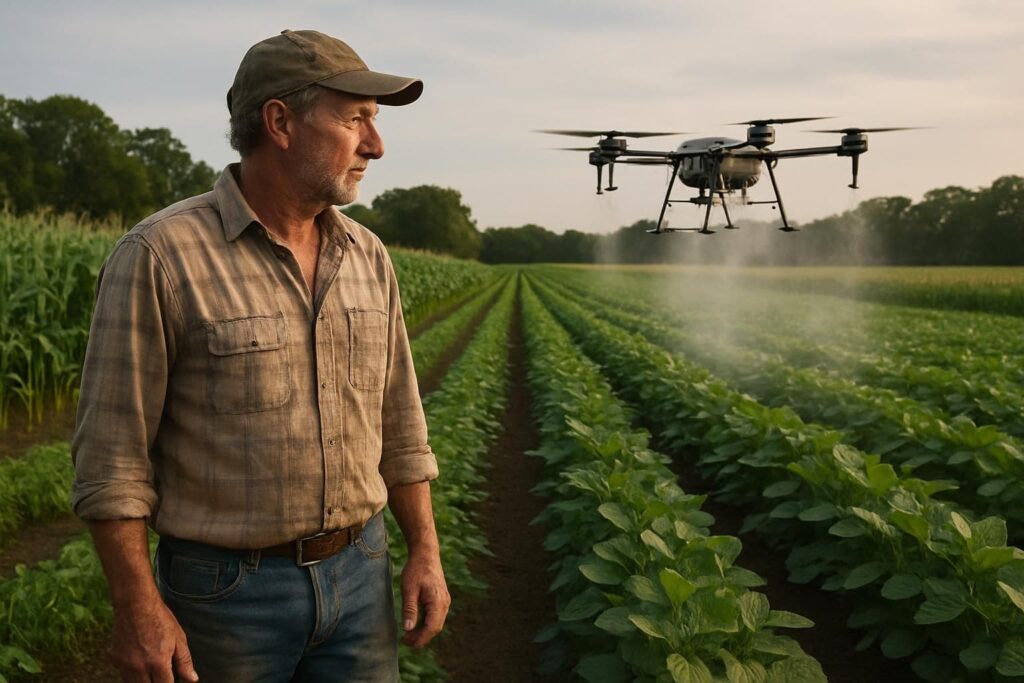Drones are reshaping the landscape of modern agriculture, introducing innovative methods of applying various substances across fields. From traditional crop protection chemicals to advanced biological agents, these unmanned aerial vehicles (UAVs) are changing how farmers manage their land. Have you ever wondered what exactly drones spray over our farmlands? This article explores six unexpected materials that precision agriculture drones utilize, highlighting their benefits and applications in today’s farming practices.
You’ll discover common substances used, the advantages of drone technology in agriculture, and even some misconceptions surrounding their use. Let’s dive into the fascinating world of agricultural drones and see how they contribute to more efficient and environmentally friendly farming.
Common Substances Sprayed by Drones in Agriculture
Drones have emerged as vital tools in agriculture, capable of carrying a variety of substances to enhance crop yields and protect plants. These UAVs are not just limited to one type of product; they efficiently distribute everything from fertilizers to beneficial insects.
What Types of Pesticides Are Used?
In the realm of pest management, drones are primarily deployed to spray three categories of pesticides: insecticides, fungicides, and herbicides. Insecticides target harmful pests that threaten crops, while fungicides combat plant diseases caused by fungi. Herbicides, on the other hand, help eliminate weeds that compete for essential nutrients and water.
Through precise application methods, drones deliver these substances directly to the affected areas. This precision not only enhances crop protection but also minimizes waste. For instance, rice fields generally receive about 15 liters per hectare, while apple orchards require approximately 20 liters for effective coverage.
Application of Herbicides via Drones
Drones equipped with specialized spray systems can deliver herbicides directly to targeted patches. These aircraft carry liquid herbicides in onboard tanks and release them through precision nozzles during flight. Operators can adjust the spray pattern and application rate using remote controls or pre-programmed paths.
Modern drone models, like the DJI Matrice series, feature advanced atomizers that produce fine droplets, ensuring effective coverage and reduced drift. As Dr. Vijay Singh of Virginia Tech points out, drone technology has evolved from basic mapping to sophisticated spraying applications.
Fertilizers Sprayed by Drones
When it comes to fertilization, drones can spray three key nutrient types: nitrogen-based compounds, phosphorus solutions, and potassium mixtures. Liquid fertilizers are particularly effective for aerial application due to their smooth flow through spray nozzles, providing even coverage.
Today’s drone systems are integrated with digital agriculture technologies that allow real-time monitoring of plant nutrient needs. This data-driven approach enables farmers to adjust fertilizer concentrations based on soil conditions, promoting healthy crop growth.
Disinfectants: A New Use for Drones
Drones have also found a role in public health, spraying disinfectants to combat disease outbreaks. During the COVID-19 pandemic, countries like China, India, and Spain employed drones to sterilize public areas efficiently. These UAVs can cover a 2-kilometer radius in just 10 minutes, making them invaluable for large-scale sanitation efforts.
By using drones, public health agencies can minimize human exposure to harmful chemicals and infectious diseases. This method allows for quick, effective response while keeping workers safe.
Special Applications of Drone Spraying
Beyond conventional crop dusting, drones are addressing specialized agricultural needs, transforming the way we approach farming.
Aerial Seeding: How Does It Work?
Drones are revolutionizing planting methods through aerial seeding. Equipped with specialized hoppers, drones like the DJI Agras T50 can carry up to 40 kg of seeds, distributing them across fields with incredible accuracy.
Using GPS and programmed flight paths, these drones ensure even seed placement. This technology reaches terrains that traditional equipment often struggles to access, such as steep slopes or muddy fields.
Deploying Beneficial Insects
Drones can also disperse beneficial insects, acting as natural pest control agents. This method enhances the effectiveness of pest management while minimizing the use of chemical pesticides. Farmers load drones with containers filled with helpful insects, which are then released over infested areas.
This targeted approach allows for greater precision compared to ground methods, effectively reducing human exposure to harmful substances.
Environmental and Agricultural Benefits of Drone Spraying
The advantages of drone spraying extend beyond mere convenience. This technology significantly lowers chemical waste and improves environmental stewardship.
Enhancing Precision in Applications
GPS technology enables drones to execute precise application patterns that traditional methods can’t match. Advanced mapping software helps operators adjust spray rates based on real-time field conditions. This targeted approach can cut chemical waste by up to 30%, ensuring optimal coverage across uneven terrains.
Reducing Environmental Impact
Drones contribute to environmental sustainability by minimizing chemical usage. Unlike traditional methods that may oversaturate fields, drones apply exact amounts of pesticides and fertilizers where they’re needed most. This approach reduces runoff, protecting waterways and soil health.
Additionally, electric drones produce zero direct emissions, further enhancing their eco-friendliness.
Addressing Concerns and Misconceptions
As drone technology evolves, so do the concerns surrounding its use in agriculture.
Myths About Chemical Spraying
Many claims about drones engaging in chemical spraying often blend fact with fiction. Professional agricultural drones are regulated and require proper certification for safe application. These operations are documented, and conspiracy theories about secret spraying programs lack credible evidence.
Public Safety Considerations
Concerns about public safety often stem from misunderstandings about drone operations. While legitimate agricultural practices may raise questions, they are governed by strict regulations to ensure safety.
As communities embrace drone technology, understanding its benefits and limitations can foster informed discussions about its role in modern agriculture.




